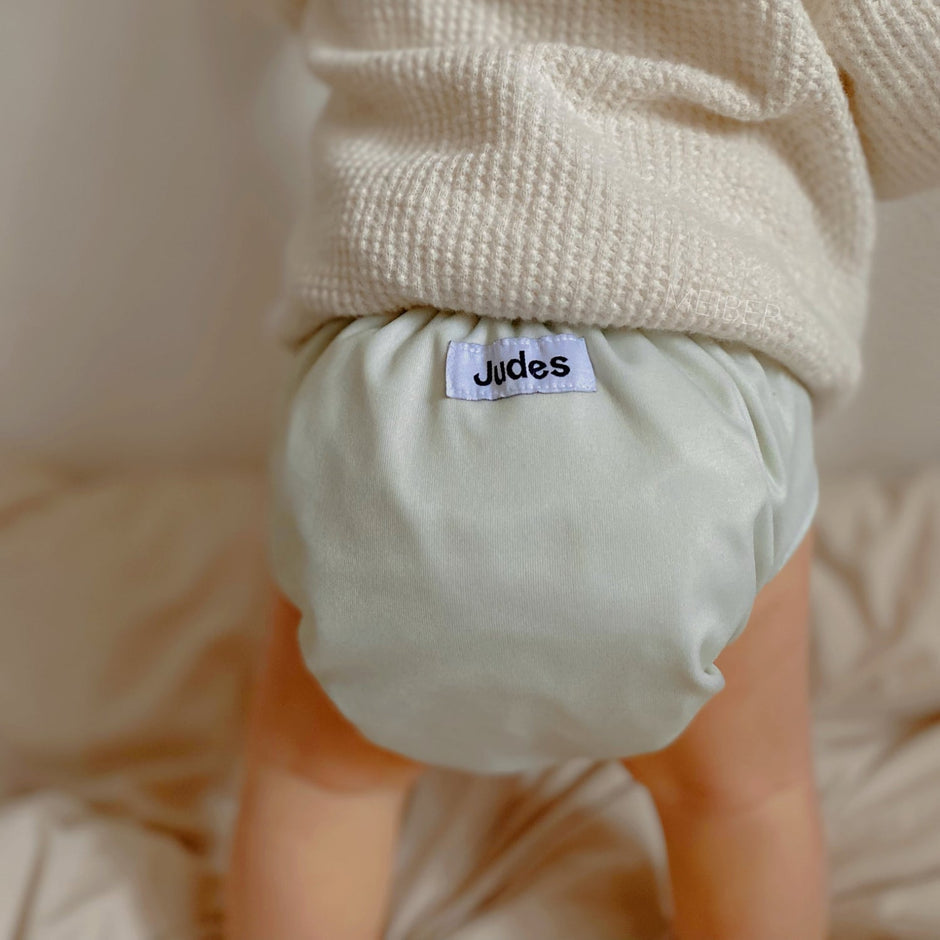Double Diapering – How to Make it Simple and Why it's Important
Updated on:
Introduction: Why is double diapering so important?
As parents, we want our children to lead healthy and happy lives. Therefore, it is important that we take care of their development early on. A challenge in this regard is healthy hip development. For the majority of our evolutionary time, we humans lived as hunters and gatherers. During this time, children were almost always carried. Today, we have a different lifestyle. Children are carried less and wear very thin disposable diapers. This can increase the risk of hip development disorders.
An example of this is hip dysplasia. This condition can lead to severe consequences in adulthood and should therefore be avoided at all costs. To prevent this danger, parents can double diaper their baby. Double diapering is a special diapering technique that allows the hips to develop healthily.
My son was one week old when signs of hip immaturity were detected. I was concerned for his health, but fortunately, there was a way to address the issue. Double diapering provided us with a simple solution, and within a few weeks, my baby's hips developed normally. Therefore, I am convinced that double diapering is an effective method to positively influence hip development.
In this article, I would like to share my experiences with double diapering and help you apply this technique correctly to optimally support your child. I explain in detail what double diapering is; its benefits; what materials you need; as well as tips for applying the technique for immature hips or hip dysplasia – everything you need to give your child the best possible start in life!
Double Diapering Advisor
Find out with just a few clicks if (and how) double diapering is right for your baby to optimally support their hip development. This advisor gives you an initial idea.
What is Double Diapering?
About 3% of children are born with hip dysplasia, making it the most common congenital malformation in babies. Further maldevelopments can arise due to our modern lifestyle (Source: Familienhandbuch). Therefore, to determine if there is a hip malposition, a newborn screening is conducted for every baby during a preventive checkup (4th to 6th week of life).
If a hip malposition is detected, one of the therapy options is double diapering. It works best with cloth diapers. Double diapering a baby means that the baby’s hips are brought into the natural ideal position with a 90° bent hip joint using the correct diapering technique. This promotes the maturation of the acetabulum within a few weeks and corrects the baby's hip position (see this study). More extreme forms may need to be addressed with a doctor-prescribed brace, splint, or even surgery.

Photo by Yuri Shirota on Unsplash
How to Recognize an Immature Hip or Hip Dysplasia
In newborns, the hip head initially consists of soft cartilage material, which matures and ossifies in the first months of life. If the hip hardens in the wrong position, it can lead to severe pain and complications in adulthood (Source: cleankids.de). To avoid permanent damage, the newborn will receive an ultrasound scan to determine the extent to which a malformation of the hip joint is present. In general, there are four different findings in this screening:
The child's hip is developing well
Here there is no noticeable finding, and treatment of the hip is not necessary; however, double diapering can still have a positive effect on hip development.
The baby's acetabulum is not yet fully matured
This means that the socket is late to mature into a healthy hip. Commonly, this is also referred to as an immature hip. Here, the femoral head is located in the middle of the joint but is not adequately covered by the acetabulum. In this case, it is possible that the bone will mature on its own in the first few weeks of life. However, the baby's hip development can and should be supported with double diapering (Source: Science Direct).
The baby has hip dysplasia
In hip dysplasia, the acetabulum is too short or too steep, and therefore the roof of the acetabulum does not sufficiently enclose the femoral head. Although the femoral head is still within the hip joint, the displacement hinders the maturation of the socket. If the hip ossifies in this malposition, there is a risk of premature wear of bones and cartilage (Source: Gelenk-Klinik). Using an orthotic (abduction pants or brace), the hip is brought into the flexed-abduction position and can mature sufficiently through movement in this position. In some cases, double diapering your baby can also suffice as an alternative to abduction pants (Source: Kinderhueftdysplasie.de).
The newborn has a subluxation or hip dislocation
With a hip subluxation (partial dislocation of the hip), the femoral head is outside the acetabulum and is “decentralizing”. Hip dislocation (complete dislocation or luxation) is the most severe form of hip disorder (very rare at 0.2 - 0.3%). Here, the femoral head is outside the acetabulum. In both conditions, the hip must first be straightened (reposition) and immobilized (retention) in order to continue with the therapy (maturation) (Source: Kinderhueftdysplasie.de).
Signs and Symptoms of a Hip Disorder
Hip maturation delay and hip dysplasia are often symptomless and painless, which is why the sonography during the ultrasound scan is such an important examination. In cases of subluxation or dislocation, the following changes are often noticeable for doctors and parents:
-
The buttock creases are at different heights
-
Different leg lengths
-
The baby spreads one leg less far away from the body
-
From the walking age, possibly sinking on the affected side and groin pain (Source: Gelenk-Klinik)
If you notice any of these abnormalities in your child, be sure to consult your pediatrician.

Are there any downsides to double diapering?
As mentioned before, babies are generally born without completely ossified hips. Therefore, it is crucial to adequately support the natural position, the spread-squat position or frog leg position. Double diapering promotes this spread-squat position and is often recommended preventatively by doctors and midwives. Still, it is always best to consult with your midwife and/or doctor, so you can't go wrong.
Which materials are suitable for double diapering?/Which diapers can I use for double diapering?
Double Diapering with Cloth Diapers
Cloth diapers are very suitable for double diapering because they are generally a bit wider in the crotch than disposable diapers. For example, you can use our Judes cloth diapers for double diapering. They are perfect for all beginners in the world of cloth diapers because they are particularly easy to use. Judes consist of an absorbent inner diaper and a waterproof yet breathable diaper cover. We have already received positive feedback from pediatricians several times.
For optimal hip positioning, you should still supplement the cloth diaper with additional diapering material. The following materials are particularly suitable for double diapering:
Muslin / Molton Cloths
These cotton cloths can be folded well to the right size and are most commonly used for double diapering.
Folded Towel
You can also simply fold a small towel and place it between the diaper and the diaper cover.
Maternity Pads
You can also use large maternity pads for double diapering, which are usually left at home after birth. However, this creates extra waste that our environment can absolutely do without.
Larger Diaper Cover
During the time you are double diapering your baby, you can also purchase a Judes diaper cover in size 2* and place the cloth between the inner diaper and the diaper cover. This even enhances absorbency, and the cloth does not slip and stays in the correct position.
Our Judes cloth diapers also have many other advantages compared to other cloth diaper brands and are a great sustainable alternative to disposable diapers.
*Children are usually double diapered in the first weeks/months of life; during this time, your baby would normally still wear size 1
Double Diapering with Disposable Diapers
You can also double diaper your child with disposable diapers. For this, you can use the materials mentioned above and place them between the diaper and the bodysuit. For better support, you can dress your baby in either a diaper cover or underpants, so everything stays in place during a lot of movement.
It is often recommended to simply use two diapers and turn the second diaper upside down. However, disposable diapers are not durable enough, and the effect of double diapering is lost. Aside from that, it also creates more avoidable waste.

This is how you properly double diaper a child – a step-by-step guide
Fortunately, double diapering is very easy. However, I will give you a brief guide and explain what you need to pay attention to when double diapering.
-
Prepare all the materials you need before diapering.
-
Fold your preferred cloth into a 15 cm wide strip. The length of the cloth should approximately match the length of the unfolded diaper.
-
Place your baby on their back and put on a fresh (cloth) diaper.
-
Now place the cloth so that it is the same length in the front and back - make sure that not too much fabric gathers at the back and your baby can still lie comfortably on their back.
-
Now pull the diaper cover or underpants over it and ensure that nothing slips.
-
You can now dress your baby in a bodysuit and all other clothing as usual.
When is the hip fully mature? How long should you double diaper for?
If there were any abnormalities during the check-up, the best treatment option will be chosen based on the degree of hip dysplasia. Progress is regularly monitored during the treatment. Your baby should be double diapered continuously, so even overnight. Kicking breaks are of course okay, but your perseverance will pay off in the end. Because the hip usually matures within a few weeks.
In our baby, the malposition was detected in the hospital during the U2 (3rd to 10th day of life) and through double diapering, no abnormalities were detectable by the checkup. And don't worry, your baby will quickly get used to double diapering and probably won't even notice it anymore.

Photo by @isabelplett
Double Diapering and Baby Carriers
Many parents wonder if the baby sling might negatively affect their child's posture and whether they can continue to carry their baby despite double diapering. Carrying in a carrier or sling is not a problem with double diapering and can even be beneficial for the hips.
This only applies if the carrier fits properly and supports the baby's natural squatting-spreading position. Therefore, you should definitely book a babywearing consultation before purchasing a carrier (a voucher makes a great gift for a birth) to find the right carrier for you and your baby.
Note: You should not carry your baby facing forward, as this counteracts your child's natural back curvature and lets the legs dangle. This can prevent proper hip development (Source: Hipdysplasia.org).
If you want to swaddle your baby, make sure you do it in a hip-friendly way, as tight swaddling of the legs can hinder the proper development of the hips. Here you can find instructions for hip-friendly swaddling.
Why should you double diaper your child?
As you can see, double diapering can be used not only for hip dysplasia but it can be beneficial for your baby's hip health in general. The most important thing is that you apply the correct technique and double diaper your baby consistently day and night. The easiest way to do this is to use cloth diapers for your baby instead of disposable ones. If you have questions or doubts, reach out to your doctor or midwife.
Did you find this article helpful? I would love your feedback! If you want to share your experiences with me and the Judes Family, feel free to leave a comment.

